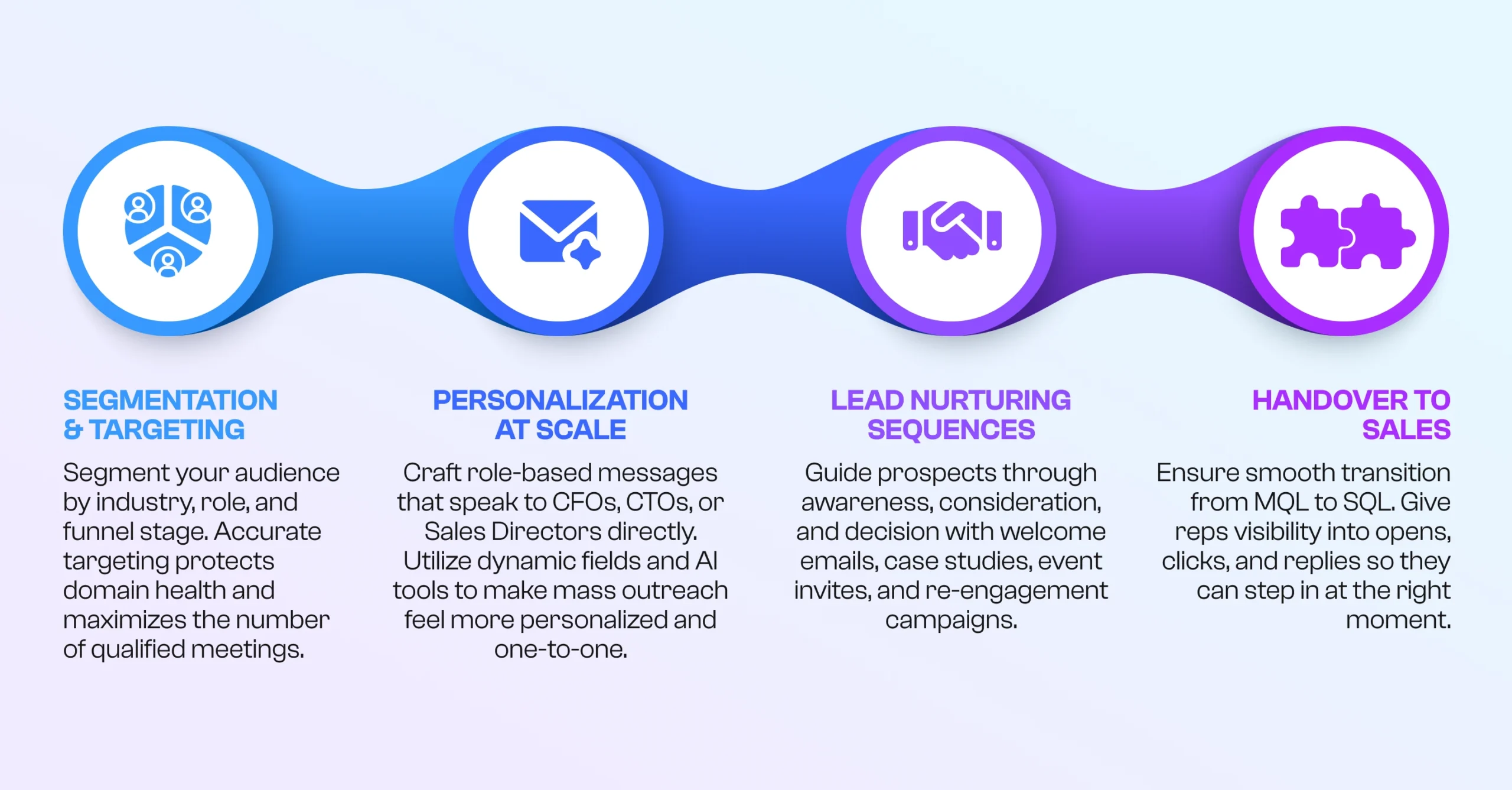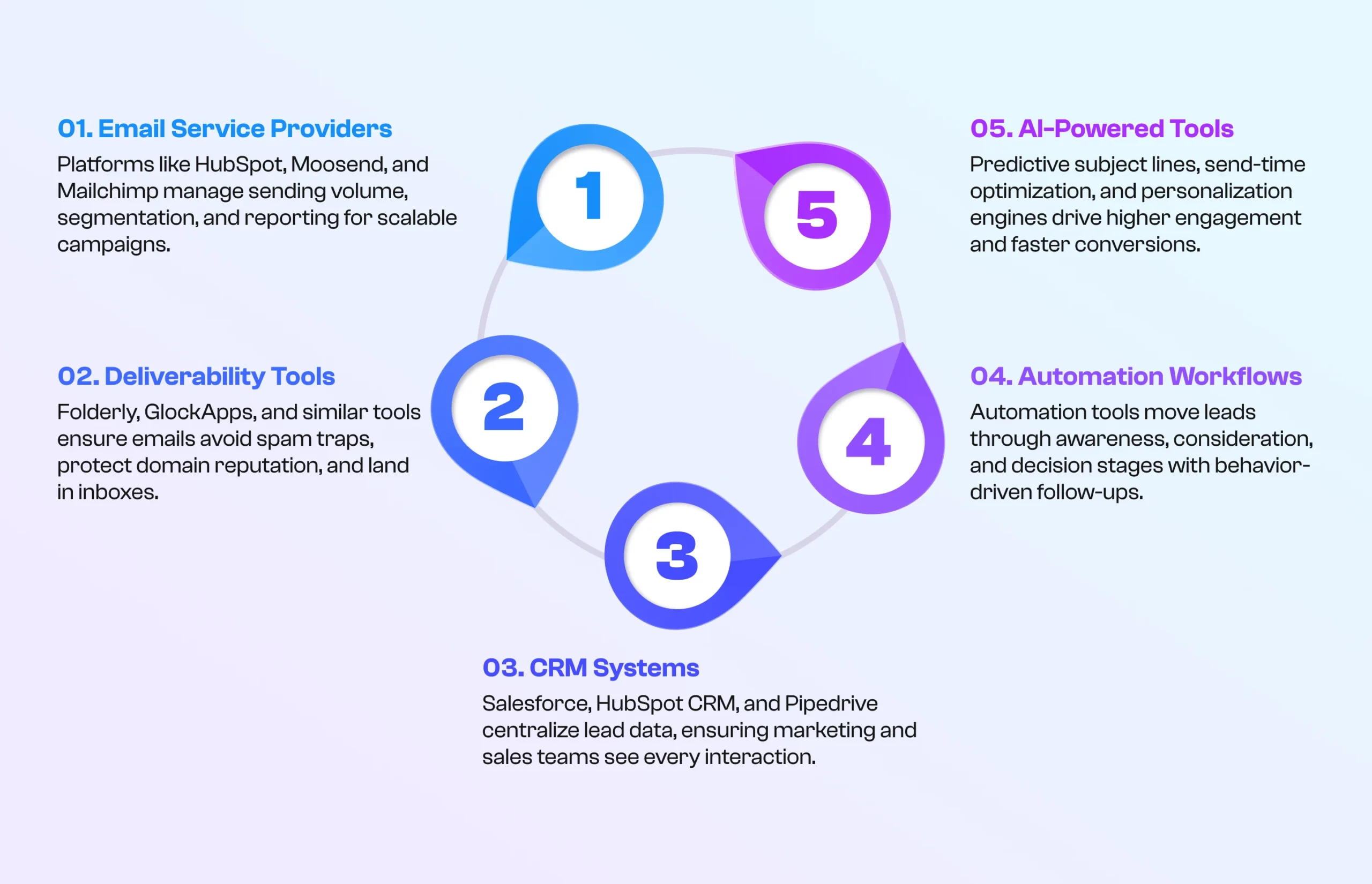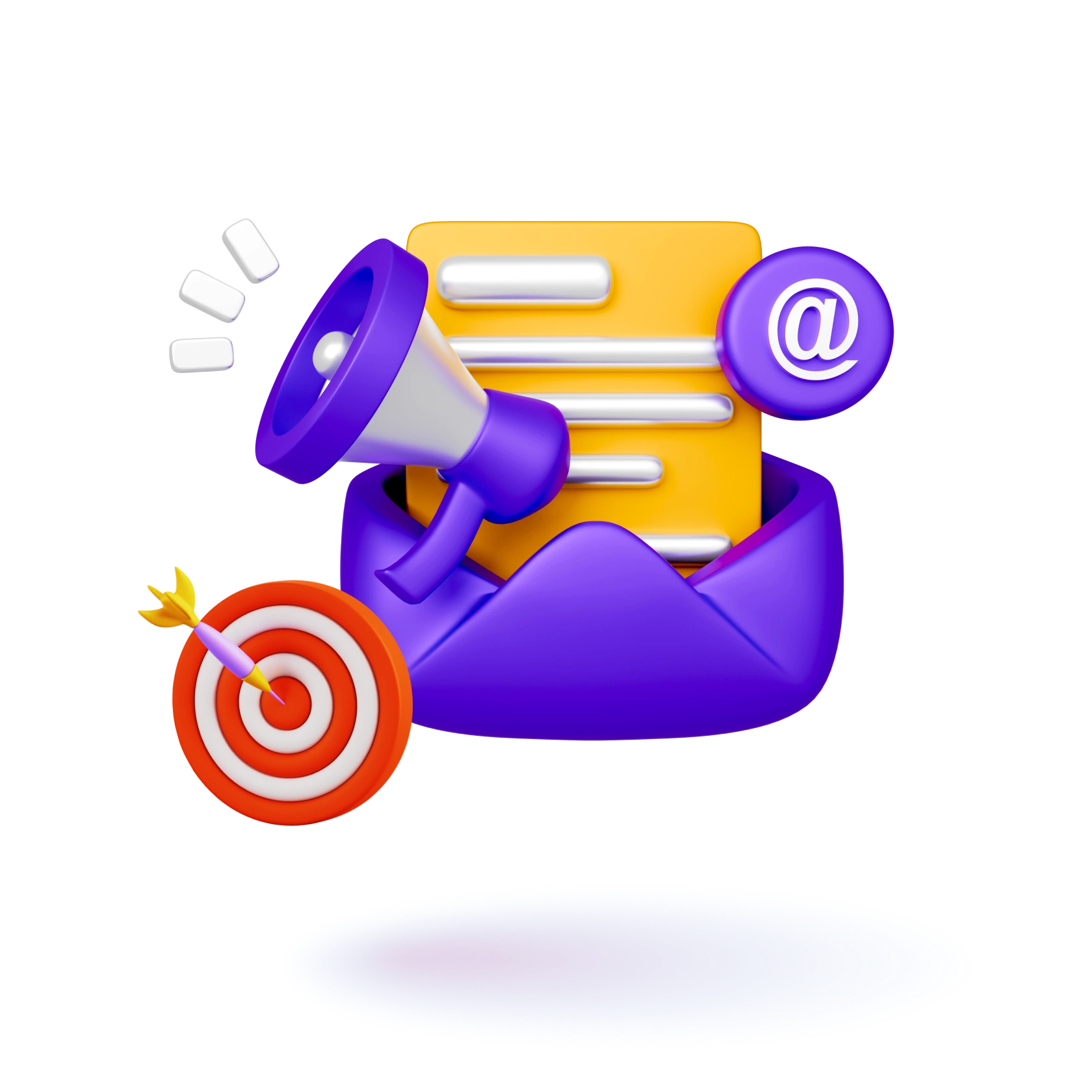LinkedIn is great for visibility, while ads are perfect for scale. But where do the conversations that lead to meetings usually happen? In the email inbox. That’s where decision-makers reply, negotiate, and move forward. It’s why top-performing teams and B2B email marketing companies keep doubling down on email as their primary lead gen channel.
Email generates an average of $36–$40 for every $1 spent — and that’s in B2B, where the buying cycle is longer and decision-making involves more stakeholders.
In this article, you’ll learn how B2B email marketing powers lead generation in 2025, how agencies design a strategy, and which best practices separate the leaders from the rest.
Why Email Marketing B2B Still Matters in 2025
When people ask if email is still relevant, the short answer is yes — especially in B2B. Unlike B2C, B2B is centered on authority and trust. Buyers evaluate, compare, and discuss internally before moving forward. Email gives space to nurture that process, making it the backbone of any modern email marketing strategy.
- 77% of B2B buyers say email is their primary channel for vendor communication. Inboxes are where they feel comfortable evaluating solutions without the noise of ads or social feeds.
- The average B2B purchase now involves 6–10 stakeholders. Email sequences can be structured to address the needs of each role and help the committee reach an agreement.
- Because decisions take weeks or even months, email provides a consistent touchpoint. Each message reinforces credibility, strengthens trust, and keeps your solution front of the prospect’s mind until the prospect is ready to become an email marketing lead.
That’s why email remains the cornerstone of lead generation strategies: it builds trust, nurtures relationships, and moves deals toward the finish line.
The Role of a B2B Email Marketing Agency
Running email marketing campaigns in-house sounds simple on paper: write some copy, hit send, wait for replies. But anyone who has tried to scale outbound knows it’s far more complex. Deliverability issues, compliance risks, and the ongoing task of list building can consume time that sales teams simply don’t have. That’s why so many companies in 2025 lean on a B2B email marketing agency to keep the pipeline flowing.
Agencies exist to take the heavy lifting off your plate. They bring the systems, tools, and expertise to manage everything from data research to sequencing. For example, GDPR and CAN-SPAM compliance isn’t something you want to get wrong — one mistake can damage your domain reputation and derail campaigns for months. Agencies protect you from that risk while making sure your outreach lands in the inbox.
To help you evaluate your options, we’ve compiled a list of the top email marketing companies shaping the industry today.
Here’s what a strong B2B email marketing company brings to the table:
- ICP research & list building: Building highly targeted lists based on your ideal customer profile, not dumping scraped contacts into sequences.
- Personalization frameworks: Crafting outreach that feels human at scale, not templated spam.
- Campaign sequencing: Designing multi-step campaigns with the right timing, tone, and follow-ups to maximize replies.
- Deliverability management: Monitoring domains, warming up inboxes, and solving placement issues before they cost you leads.
- Transparent reporting: Clear dashboards that show qualified replies and ROI.
At SalesAR, we’ve seen firsthand how powerful this approach is. For example, one of our U.S. clients received 875 replies and booked 75 meetings in just a few months of working with us. That’s the difference between sending emails and building a real lead generation engine.
When you partner with the right agency, you’re gaining a team that integrates seamlessly with your sales process, accelerates your pipeline, and frees your reps to do what they do best: close deals.
Partner with SalesAR and turn email outreach into a predictable sales pipeline.
How Email Marketing B2B Lead Generation Works
Email lead generation is about sending the right messages to the right people at the right time. That starts with targeting and then scaling personalization so that every prospect feels like the message was written specifically for them.

Step 1: Segmentation & Targeting
The first step in effective B2B email marketing is segmentation. Instead of blasting a single message to thousands of contacts, you break down your audience by firmographics such as industry, company size, or geography. From there, you add role-specific filters: is this person a budget holder, an influencer, or a user? And finally, you layer in the funnel stage, ensuring that prospects who have already engaged with your content don’t receive the same messaging as cold leads.
SalesAR Insight: Targeting the wrong people wastes resources and hurts your results. High unsubscribe rates, low engagement, and spam complaints can damage your sender reputation and cause future campaigns to be sent to the junk folder. By starting with accurate segmentation, you protect your domain health and maximize your chances of booking qualified meetings.
Step 2: Personalization at Scale
Once you know who you’re reaching, the next step is making sure your outreach resonates. Personalization today goes way beyond “Hi {FirstName}.”
For example:
- CFOs prioritize ROI, cost savings, and operational efficiency.
- CTOs seek seamless integration, optimal performance, and scalability.
- Sales Directors want pipeline acceleration, higher reply rates, and qualified meetings.
When you align your messaging with what each role values most, your chances of getting a response skyrocket. Dynamic fields, role-based templates, and AI-powered personalization tools make this process scalable, transforming personalization into a repeatable email marketing strategy rather than one-off efforts.
Step 3: Lead Nurturing Sequences
Once you’ve segmented and personalized your outreach, the real work begins: nurturing. Very few B2B buyers make a decision based solely on a single email. That’s why structured email marketing lead nurturing sequences are so effective at moving prospects forward. They guide prospects through the stages of awareness, consideration, and decision, keeping your solution top of mind without overwhelming them.
Common examples of nurturing sequences include:
- Welcome sequence sets the tone, shares value upfront, and introduces resources that position your company as a trusted partner.
- Educational drips provide case studies, whitepapers, or insights that align with specific buyer pain points. This builds credibility and demonstrates expertise.
- Event invites & reminders keep prospects engaged by offering webinars, demos, or exclusive industry events where they can learn more.
- Re-engagement campaigns win back dormant leads with fresh content or tailored offers that reignite interest.
SalesAR Insight: Companies using lead nurturing generate 50% more sales-ready leads at 33% lower cost compared to those that don’t. In other words, nurturing makes your marketing budget go further.
Step 4: Handover to Sales
All the nurturing in the world means nothing if leads get stuck between marketing and sales. That’s why a clear handover process is critical. A lead typically moves from MQL (Marketing-qualified) to SQL (Sales-qualified) when engagement signals are strong.
When marketing and sales are aligned, there’s no “black hole” where warm leads get lost. Instead, the handover is seamless, and reps can jump in at the right time with a conversation that feels natural, not forced.
When built right, B2B email marketing becomes a system that steadily turns cold prospects into meetings and qualified opportunities.
Best Practices From Leading B2B Email Marketing Companies
If you look at what separates average outreach from the campaigns run by top B2B email marketing companies, the difference isn’t flashy design or aggressive volume. It comes down to precision, personalization, and discipline. The best firms treat email as an ongoing system, not a one-off blast, and they apply consistent best practices that keep their clients’ pipelines healthy.

Deliverability and List Hygiene
No matter how good your copy is or how strong your offer looks, none of it matters if your email never makes it past spam filters. Deliverability is the foundation of B2B email marketing, and treating it as anything less than mission-critical is a recipe for failure. Strong agencies know this, which is why they dedicate time and resources to maintaining healthy inbox placement.
A single list containing unverified or outdated addresses can significantly impact engagement rates, increase bounces, and trigger spam filters. That ripple effect can poison an entire domain’s reputation, causing even your best-crafted campaigns to disappear into junk folders. In B2B, where a single meeting can be worth tens of thousands of dollars in pipeline, that’s a risk no company can afford.
Here are the deliverability and list hygiene best practices:
- Validate email addresses before launching sequences. Use verification tools to weed out invalid or temporary addresses before you hit send. This prevents high bounce rates that signal spam behavior to providers.
- Remove bounced or unengaged contacts regularly. If someone hasn’t opened or replied in months, keeping them on your list does more harm than good. Cleaning lists protects your domain and focuses energy on real prospects.
- Monitor domain health across all sending accounts. Reputation is scored per domain and per IP. Agencies track spam complaints, engagement, and authentication (SPF, DKIM, DMARC) to maintain positive signals.
- Utilize tools to identify spam traps and prevent blacklisting. Tools like Folderly or GlockApps help detect hidden issues that aren’t visible in standard reporting but can destroy deliverability.
Validated lists yield higher open and reply rates, enabling your email marketing campaigns to scale successfully without compromising your reputation. Clean domains mean sequences scale without penalty. And healthy engagement signals (opens, clicks, replies) tell email providers your campaigns belong in the inbox, not the spam folder.
SalesAR Insight: New domains need time to build credibility before they can handle thousands of emails per week. At SalesAR, we systematically warm up domains to build trust with providers and rotate sending across accounts to spread the load. This way, no single domain gets flagged, and clients maintain consistent inbox placement even at scale.
Clear, Single-Minded CTA
The call-to-action is where all your effort either pays off or falls flat. You can have the perfect subject line, sharp copy, and great targeting, but if your email leaves the reader wondering “what do I do next?” — you’ve lost them. The truth is, one of the biggest mistakes in B2B email marketing is asking for too much at once.
Strong campaigns focus on one clear action. That might be booking a call, replying with interest, or downloading a case study. But it can’t be all three. Multiple CTAs create confusion and dilute urgency. When decision-makers are scanning their inbox between meetings, clarity always wins.
Here’s what works best:
- Keep CTA copy concise and direct. Phrases like “Book a 15-minute call” or “Reply with interest” are more effective than vague requests.
- Avoid mixing multiple asks in one email. One goal per message ensures your prospect knows exactly what to do.
- Make the next step frictionless. Include a calendar link, suggest specific times, or use a one-click download option. The easier it is, the higher the conversion.
Interestingly, in B2B outreach, plain-text CTAs often outperform buttons. Why? Because they feel personal. A hyperlink in a sentence mirrors how colleagues email each other, while buttons can scream “marketing blast.” Subtlety matters when building trust with executives and buyers.
Mobile Optimization
Here’s a number that changes how you should think about email: more than 40% of B2B decision-makers check their inbox on mobile devices. That means almost half of your prospects are skimming on a phone between calls, in an airport lounge, or during their commute. If your subject line gets cut off or your design breaks on mobile, you’ve lost the chance to connect.
Optimizing for mobile is the baseline for credibility. Executives won’t pinch, zoom, or scroll endlessly to read your pitch. If your message isn’t easy to consume in a few seconds, they’ll swipe it away.
Here’s how to make sure your campaigns hold up:
- Use responsive templates. Modern ESPs allow layouts that automatically adjust to any screen size. This prevents broken designs and ensures images and text don’t overlap.
- Keep subject lines short. On mobile, anything longer than 40–50 characters risks getting cut off. Clear and direct beats clever but truncated.
- Write for scanning, not reading. Short paragraphs, bullet points, and bold keywords enable busy readers to grasp the key message at a glance.
- Test across devices. What looks clean on Gmail desktop can break on Outlook mobile. Always preview emails on multiple devices and with various clients before launch.
When you make emails easy to read and act on in under a minute, you increase the likelihood of replies and meetings. If your campaigns aren’t mobile-friendly, nearly half your audience won’t even see your message the way you intended. And in B2B, missing that window means missing real opportunities.
Automation Workflows Integrated With CRM
One-off email blasts don’t cut it in B2B. The strongest agencies build automation workflows that guide prospects step-by-step through the buyer journey. These workflows ensure every lead receives the right message at the right stage, and that no opportunity slips through the cracks.
A well-structured system includes nurturing sequences for awareness, educational content during consideration, and product-focused follow-ups at the decision stage. Instead of guessing what to send next, automation delivers a consistent experience that builds trust and keeps prospects engaged over weeks or months.
Here’s what makes these workflows effective:
- Align with buyer stages. Early emails introduce value and industry insights, mid-stage sequences highlight case studies, and late-stage campaigns focus on demos, ROI, and implementation.
- Automate follow-ups. Few people reply after the first message. Automated reminders and check-ins keep conversations alive without overwhelming your sales reps.
- Trigger content by behavior. If a lead downloads a whitepaper, the system sends a related case study. If they attend a webinar, the next step might be an invitation to a demo. Behavior-driven automation makes your outreach feel relevant and timely.
- Sync everything with the CRM. Sales needs full visibility into opens, clicks, replies, and downloads. When workflows are integrated with the CRM, reps know precisely when a lead is warm and ready for outreach.
The result is a seamless handoff between marketing and sales. Instead of cold transitions, reps pick up where automation leaves off, armed with context about what the prospect has read or downloaded.
The real power lies in these workflows running automatically, moving leads forward without manual effort. Discover our comprehensive guide on how to automate lead generation effectively.
Metrics That Matter
Too many teams still obsess over open rates. The best B2B email marketing companies look deeper, focusing on metrics that tie directly to revenue.
- Replies: Are prospects engaging with your message?
- Meetings booked: Are conversations turning into opportunities?
- Pipeline impact: How many opportunities are sourced from email?
- Closed revenue: Which deals started from outreach?
Build a feedback loop between marketing and sales. This ensures that insights from conversations (objections, pain points, competitor mentions) make their way back into targeting and messaging.
Email is only one piece of the puzzle. To gain a deeper understanding of the bigger picture, consider examining the key lead generation KPIs that every team should track.
Tools & Technology for Email B2B Marketing in 2025
Email marketing has always been about sending the right message — but today, technology is what makes that possible at scale. The stack you use is no longer a “nice-to-have.” It’s the difference between hitting inboxes with relevance or getting buried in spam. Let’s break down the tools and software that matter most in B2B email marketing today.

Email Service Providers (ESPs)
Every campaign begins with the platform you use to send it. Your ESP manages sending volume, segmentation, templates, and reporting. The best ones are designed to handle complex B2B needs, such as multi-step nurturing sequences, integration with CRMs, and GDPR compliance.
- HubSpot – Ideal for teams that want marketing, sales, and CRM under one roof. Its workflows make it easy to build end-to-end campaigns.
- Moosend – Known for affordability and automation flexibility, an excellent fit for smaller companies looking to scale.
- Mailchimp – Still popular for its simplicity and adoption, though more limited in advanced B2B automation compared to HubSpot.
Deliverability Tools
Your beautifully crafted campaigns don’t matter if they land in spam. That’s why deliverability tools are essential. These platforms test placement, diagnose issues, and maintain your sending reputation.
- Folderly – Specialized in diagnosing why emails hit spam and fixing domain reputation problems.
- GlockApps – A deliverability testing suite that shows whether your emails land in inboxes, promotions, or spam across providers like Gmail and Outlook.
Think of these tools as insurance. Without them, you’re guessing whether campaigns are even being seen.
CRM & Automation
B2B marketing doesn’t stop at the send button. Once a lead engages, their data needs to flow seamlessly into sales systems. CRMs and automation tools make sure no interaction gets lost.
- Salesforce – The enterprise gold standard. Complex, customizable, and built for global teams.
- HubSpot CRM – User-friendly and fully integrated with HubSpot’s marketing suite, making it a favorite for SMBs and mid-market teams.
- Pipedrive – Streamlined and affordable, with automation that works well for smaller sales teams that need visibility without the bloat.
When your CRM and email systems sync, sales can see every open, click, and reply. That context makes follow-ups more informed and timely.
AI-Powered Tools
Here’s where 2025 feels different. AI is now embedded in every advanced B2B email marketing strategy, optimizing subject lines, send times, and personalization. From predicting which subject lines will be opened to adjusting send time based on behavior.
- Predictive subject lines – AI analyzes millions of data points to craft subject lines that drive higher opens.
- Send-time optimization – Algorithms identify when each prospect is most likely to engage, scheduling emails to hit inboxes at those exact moments.
- Personalization engines – Tools that pull industry pain points, case studies, and role-based messaging into dynamic fields, making mass outreach feel one-to-one.
The impact? Higher engagement, lower unsubscribe rates, and faster movement from MQL to SQL. AI-driven personalization can increase sales by up to 10%, which in the B2B sector can translate to millions in the pipeline.
Future of B2B Email Marketing
AI is already reshaping how campaigns work. Instead of generic sequences, emails are triggered by real behavior, such as downloading a resource, visiting a pricing page, or attending a webinar. Predictive engines will go even further, automatically suggesting content that resonates with each role in the buying committee.
The strongest systems will sync with LinkedIn outreach, targeted ads, and retargeting campaigns. Picture a prospect receiving a case study in their inbox, seeing a testimonial ad on LinkedIn the next day, and then being invited to a webinar. Every touchpoint reinforces the message, driving higher engagement.
Looking ahead, expect fewer but far more intelligent emails: personalized, context-aware, and integrated into a modern B2B email marketing strategy. For B2B teams, this means higher-quality conversations, stronger relationships, and pipelines that grow with precision rather than volume.
Conclusion
Email hasn’t lost its edge. In 2025, it remains the cornerstone of B2B lead generation; however, the difference between average and outstanding results largely depends on how you make it work for your business.
Whether you choose to optimize campaigns in-house or partner with a B2B email marketing agency, success comes from continuous testing, close alignment with sales, and data-driven personalization. When you commit to these practices, email becomes the system that consistently turns prospects into qualified opportunities.
Partner with SalesAR and let’s build a predictable pipeline together.
FAQ
What is B2B email marketing for lead generation?
It is the process of using targeted email outreach to identify, engage, and convert potential business buyers into qualified leads. Instead of generic blasts, it relies on segmentation, personalization, and nurturing sequences that guide decision-makers through the sales funnel.
Should companies use cold emails for lead generation?
Yes, when done correctly, cold emails remain one of the most effective ways to start conversations in B2B. The key is to avoid spammy tactics. When supported by a clear strategy, cold emails can drive predictable growth.
How can businesses measure the success of B2B email marketing?
Companies should track replies, meetings booked, pipeline impact, and closed revenue to manage their operations. The most advanced campaigns tie metrics directly to sales outcomes.
What role does automation play in B2B email lead generation?
It ensures the right message is sent at the right time, based on buyer behavior. Integrated with CRM, automation provides sales representatives with full visibility, making handoffs seamless and ensuring that no qualified leads slip through the cracks.


